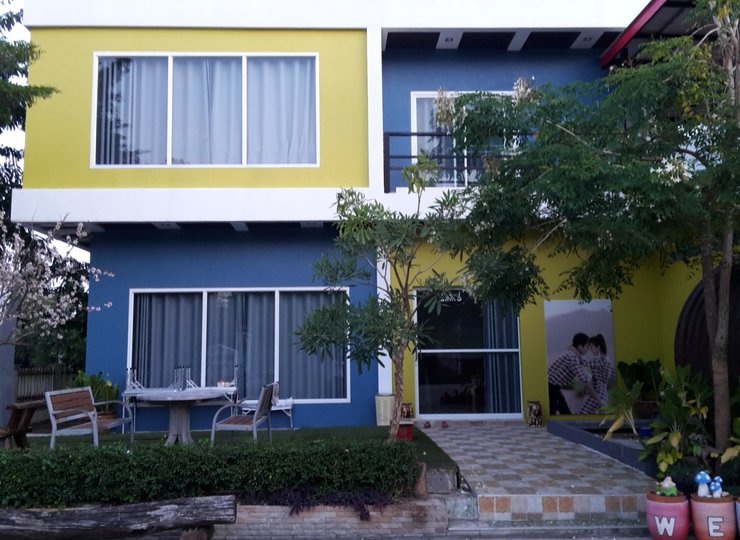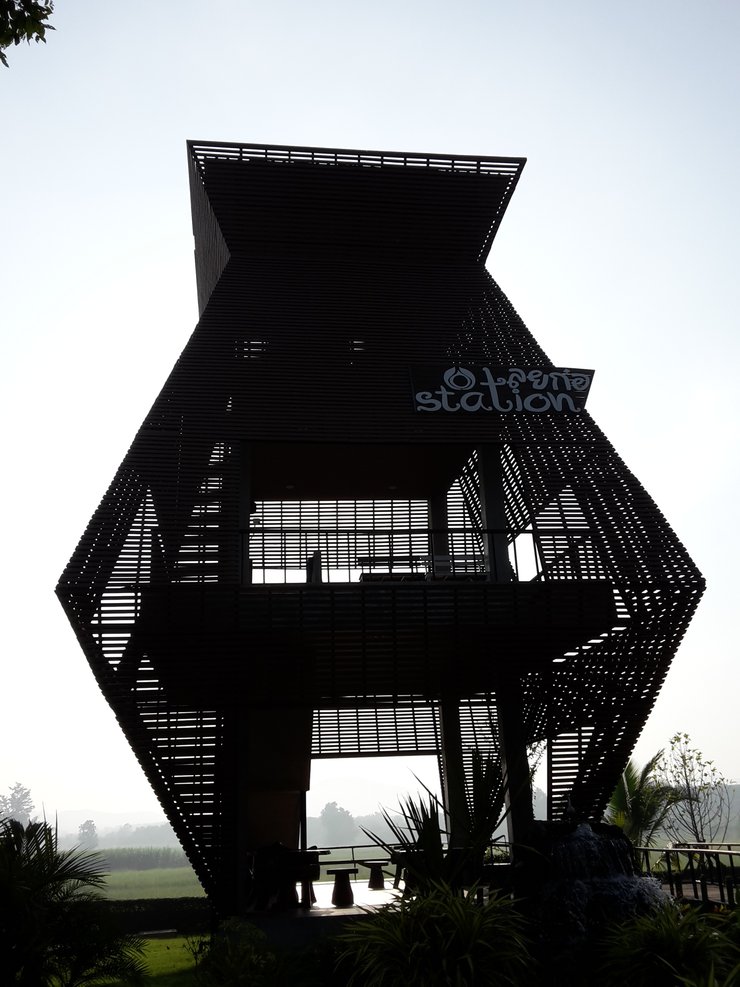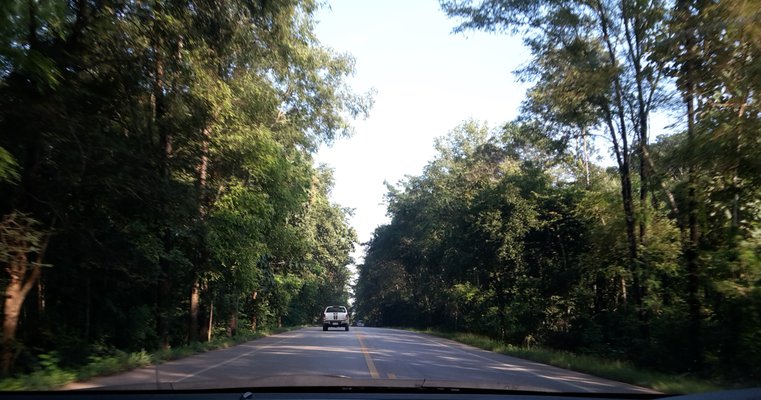Hello.
This trip, we indulged ourselves in the verdant hues of meadows and the serenity of flowing water. We ascended Mount Thok, taking in the breathtaking vistas of the northeastern region. This impromptu escapade was not meticulously planned; rather, it was driven by a yearning to revisit Mount Khao Kradong after several decades. We pondered whether we still possessed the stamina for such an endeavor.
Departing from work at 3 pm, we embarked on a road trip as the sun began to set. We opted for the scenic route via Mittraphap Road, venturing through Sikhio and onto Highway 201 towards Chaiyaphum and Chumphae. Taking a left turn onto Route 12, we then made a right turn towards Phu Kradueng National Park.
We arrived around midnight and stayed here.



The distance from our accommodation to Phu Kradueng National Park is about 4 kilometers. It was still early in the morning, but there were already tourist cars parked and waiting. We contacted the park officials and were told that all accommodations were fully booked. We had actually anticipated that there would be fewer tourists during our visit, as it was not a popular time to visit Phu Kradueng. However, we were wrong in our prediction. As a result, we had to change our plans and continue driving.

Green contentment by the roadside


We will stop here to refuel.


The rice paddy behind the gas station is lush and green.



I decided to visit Kaeng Kut Ku in Loei province to admire the river, mountains, and lush greenery.


Luang Prabang is 425 kilometers away... then which way should I go?


Sky, water, and mountains.


Vibrant Souvenirs at Kaeng Kut Ku
This sentence describes the colorful souvenirs available at Kaeng Kut Ku.



Departing from Kaeng Khut Khu, follow the Mekong River.

The Mekong River reveals its islets in certain stretches.



In some sections, the water is so shallow that it is non-existent.

Across the river is Vientiane.


This appears to be a newly constructed site, potentially intended as a scenic viewpoint overlooking the Laotian side. However, it is currently deserted and devoid of visitors. It may evolve into a landmark in the future.




Visit the Thai-Lao Friendship Bridge


We stayed at the Century Grand Hotel, located in Bueng Kan Province.


Photographed from the hotel room



This morning, we decided to visit Phu Tok. We took Highway 212 through Pho Chai and Pak Daet districts. We turned right onto Highway 222 and reached Si Wilai district. There was a left turn that passed through Ban Na Sing and Ban San Sai Ngam villages, leading to Ban Kham Daen. After approximately 20 kilometers, we arrived at Phu Tok.
This is a land of faith and righteousness.
Phu Thok Temple, also known as Chetiya Sriwihan Temple, is located in Ban Kham Daen, Sri Wilai District, Bueng Kan Province. The temple was founded by Phra Ajarn Juan Kulchettho in 1969. According to historical records, the area was once a dense forest inhabited by various wild animals. Phra Ajarn Juan began his mission by establishing a small hut and relying on alms from the villagers of Ban Kham Daen. With the help of monks and devotees, a staircase was constructed leading up the mountain within two months. Through the unwavering faith of generous donors, the temple has gradually developed over time.
In 1971, the construction of the spiral staircase around the mountain began. Venerable Juaan's concept was "using two main posts as the base, then using two beams, tying them tightly and extending them out 4 meters. Take the rope tied to the end of the extended beam and then tie the beam to the main post that has been planted. Then you can sit and drill holes comfortably." This concept was inspired by honey hunters, who were abundant in the Phu Thok area. During the honey harvesting season, honey hunters would climb the mountain in this manner.
When Venerable Ajahn Juan's theoretical ideas were discussed with various experts, none of them agreed with him. Even the honey collectors were hesitant to take the risk. Undeterred, Venerable Ajahn Juan decided to undertake the task himself. Once he began, he encountered no problems and was able to complete the project. Subsequently, villagers began to assist him. He attributed his success to a calm mind, concentration, and the courage to take action.

The entrance consists of a series of concrete steps leading upwards.



The first and second floors are connected by a wooden staircase with landings at regular intervals.






Rock Formation



From the 3rd floor, there are two separate paths. The left path leads directly to the 5th floor, while the right path leads to the 4th floor.
The fifth level is considered the middle level. It features a large pavilion, monks' quarters, and Buddha statues lined up under the rock face.









Green views surround the area. The bridge is smooth when walking up to floors 4-5-6-7.








The walkway is adorned with Buddha statues and religious teachings.



Each plank on this precarious walkway represents a testament to perseverance, diligence, and courage.




Cargo pulley for transporting goods or building materials


The Chedi of Venerable Juaan, built in 1986. Aerial view from Phu Tok.

To the north, a bridge can be seen leading to the temple housing the relics of the Buddha.

The mountain behind is a large mountain that is not open to tourists or pilgrims.

















Conclusion
Phu Thok consists of two mountains: the small and the large. The area open to visitors or pilgrims is the small mountain, which has a total of 7 levels. Levels 1-2 involve walking up wooden stairs at intervals, with resting places along the way. Some sections require crawling through narrow and steep passages. Level 3 introduces winding stairs. Level 5 is a wide open space with a Buddha statue,僧侣住宿, and a place of worship. Levels 6-7 involve winding stairs along the cliff, offering scenic views. Visitors are advised to exercise caution while walking.
This place allows us to see and learn about the Dharma, where diverse ideas on simplicity can lead to great success. By overcoming fear with courage, calmness, and mindfulness, we can achieve our goals.
See you on the next trip.
enjoyinglife
Tuesday, October 8, 2024 11:18 AM













